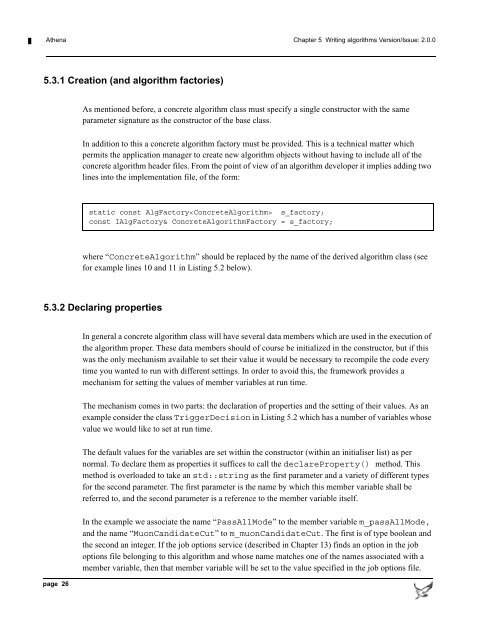Athena Developer Guide
Athena Developer Guide
Athena Developer Guide
Create successful ePaper yourself
Turn your PDF publications into a flip-book with our unique Google optimized e-Paper software.
<strong>Athena</strong> Chapter 5 Writing algorithms Version/Issue: 2.0.0<br />
5.3.1 Creation (and algorithm factories)<br />
As mentioned before, a concrete algorithm class must specify a single constructor with the same<br />
parameter signature as the constructor of the base class.<br />
In addition to this a concrete algorithm factory must be provided. This is a technical matter which<br />
permits the application manager to create new algorithm objects without having to include all of the<br />
concrete algorithm header files. From the point of view of an algorithm developer it implies adding two<br />
lines into the implementation file, of the form:<br />
static const AlgFactory s_factory;<br />
const IAlgFactory& ConcreteAlgorithmFactory = s_factory;<br />
where “ConcreteAlgorithm” should be replaced by the name of the derived algorithm class (see<br />
for example lines 10 and 11 in Listing 5.2 below).<br />
5.3.2 Declaring properties<br />
In general a concrete algorithm class will have several data members which are used in the execution of<br />
the algorithm proper. These data members should of course be initialized in the constructor, but if this<br />
was the only mechanism available to set their value it would be necessary to recompile the code every<br />
time you wanted to run with different settings. In order to avoid this, the framework provides a<br />
mechanism for setting the values of member variables at run time.<br />
The mechanism comes in two parts: the declaration of properties and the setting of their values. As an<br />
example consider the class TriggerDecision in Listing 5.2 which has a number of variables whose<br />
value we would like to set at run time.<br />
The default values for the variables are set within the constructor (within an initialiser list) as per<br />
normal. To declare them as properties it suffices to call the declareProperty() method. This<br />
method is overloaded to take an std::string as the first parameter and a variety of different types<br />
for the second parameter. The first parameter is the name by which this member variable shall be<br />
referred to, and the second parameter is a reference to the member variable itself.<br />
page 26<br />
In the example we associate the name “PassAllMode” to the member variable m_passAllMode,<br />
and the name “MuonCandidateCut” to m_muonCandidateCut. The first is of type boolean and<br />
the second an integer. If the job options service (described in Chapter 13) finds an option in the job<br />
options file belonging to this algorithm and whose name matches one of the names associated with a<br />
member variable, then that member variable will be set to the value specified in the job options file.
















